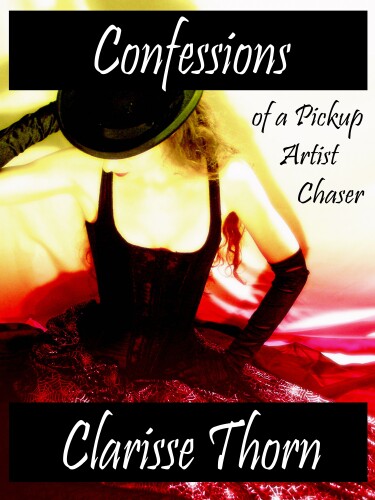For a couple of years now, Clarisse Thorn has been interviewing and hanging out with the community of pick-up artists, a community she finds fascinating and… well, from a feminist perspective, sort of problematic, too.
There’s an unbelievably compelling thing that happens when you combine one of your interests (flirting! analyzing human behavior! body language!) with that consistent prickling, nettle that’s sometimes irritation and sometimes anger. I know that exploring the cognitive dissonance of horror and fascination has led to some of my more interesting obsessions. Clarisse’s book captures that frenetic, obsessive feeling, as well as including a large amount of clear-eyed, sharp analysis.
CONFESSIONS OF A PICK-UP ARTIST CHASER: LONG INTERVIEWS WITH HIDEOUS MEN
Currently $2.99 on Amazon, price to go up on March 17th.
At the goth club, one PUA was too involved in making out with his gorgeous girlfriend to talk to me. I still managed to get his number, though. He was on the scrawny end of slender, and he looked awesome in eyeliner. Five minutes of conversation showed me that he was an expert on feminism and polyamory, and he was an S&M switch just like me. His name was Brian.
A few days after the goth club outing, Brian and I started talking about meeting for drinks. We were both busy, though, and had to reschedule several times before we met. As we sized each other up, I tried to explain what drew me to PUAs like a moth to a flame.
“I don’t know,” I said, fumbling for words. “It’s interesting from a feminist perspective, but it’s more than that. It’s like….” I looked away from him and thought about where else in my life I felt this intense, sexually-tinged fascination. “It’s like a fetish.”
He started laughing. “You’re a PUA chaser!” he cried, and I had to agree.
Clarisse dissects the pick-up artist movement in a way that’s easy and intuitive to read for people who aren’t familiar with it, and does a good job of balancing insightful feminist critique with generosity toward her interview subjects. Readers will probably have different reactions to that balance–I fully expect this is a book which some PUAs will call irredeemably vicious and some feminists will find frustrating for its light hand. I come down somewhat more grouchy and skeptical than Clarisse Thorn does in the narrative, but I don’t think that’s a barrier to reading the text; in fact, I think Clarisse’s generosity makes the analysis much more interesting than it would otherwise be since it creates subtle, highly finessed arguments.
Clarisse’s analysis is as interesting, easy-to-follow and well-laid out as it is in all of her writing, but the most compelling thing in this book is not the analysis itself (which I was expecting), but the way in which Clarisse uses memoir to supplement her analysis. Clarisse is a brilliant sex writer with what appears to be (on the page, at least) an unflinching ability to reveal personal information. That talent is highlighted here as Clarisse fleshes out scenes that create a parallel emotional and intellectual journey, allowing the reader to travel with her through the insights and frustration of her time on the fringes of the pick-up artist community. Her intelligent writing about S&M and polyamory help establish her presence in the text as someone with a subaltern point of view, and place pick-up artistry within the context of other sexual subcultures so that the book’s criticism is grounded in an almost ethnographic framework which works to keep the text from becoming sensationalist or exotifying.
I found a few nitpicks from a social justice perspective as I think is inevitable with this type of book, and I’m sure that others would find different ones. Reading with my writer’s eye, I’d suggest that the book could use a 5-10% trim, particularly between the halfway point and the two thirds point. Leaving aside those points, I found this a really interesting read, and I would particularly recommend this book to anyone who has found feminist writing about the pick-up artist movement intriguing in the past.
**
Speaking of writing about sex and relationships, Clarisse Thorn is the Sex + Relationships Section Editor for Role/Reboot, a website devoted to investigating the modern upheaval in gender/sex roles. A few months, she invited me to write something for them which I finally got around to; the result was posted last week.
THE STORY OF LEAH AND VANESSA:
We were all in college together, 19 years old and naïve as hell (call it equal parts ignorant and innocent) when our friend Leah met this girl.
This older girl.
“She’s how old?” we asked.
Presumably, some individual one of us asked, but it’s not worth distinguishing; our incredulity was unanimous.
She fidgeted uncomfortably. “35.”
“Thirty-five? Vanessa is 35? And you made out with her?”
“I thought she was 30!” she protested. “She told me she was 30. Then we made out. Then she admitted she was really 35.”
We narrowed our eyes at Leah and glared. Vanessa lied about her age was not making it seem like Leah’s new love affair was a better idea than we’d previously thought.
The full article is at the link.




Thanks, Mandolin.
The middle part to the later two-thirds was tough. It was really hard to figure out what to cut while still pulling together all the threads I wanted to weave in. A number of people said it was too long, but then when I asked what they actually thought should be cut, they had trouble coming up with anything specific either …. So I just went with it all. Not ideal, but I figure that at least I made all the points I wanted to make : )
A perfectly reasonable thing to do!
“I am sorry to write such a long letter. I didn’t have time to write a short one.”